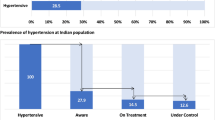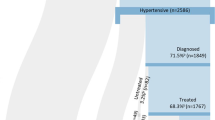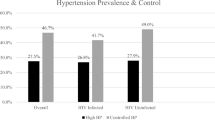Abstract
Cardiovascular disease is the leading case of mortality from non-communicable diseases (NCD) in India. The government’s National Programme for Prevention and Control of Cancer, Diabetes, Cardiovascular Diseases and Stroke seeks to increase capacity building, screening, referral and management of NCDs across India, and includes community-based outreach and screening programmes. The government in India routinely provides basic care at religious mass gatherings. However, in 2015, at the Kumbh Mela in Nashik and Trimbakeshwar, the state government extended its services to include a hypertension screening programme. We examine here the value and implications of such opportunistic screening at mass gatherings. At the Kumbh, 5760 persons voluntarily opted for hypertension screening, and received a single blood pressure measurement. In all, 1783 (33.6%) screened positive, of whom, 1580 were previously unaware of their diagnosis. Of the 303 that had previously known hypertension, 240 (79%) were prescribed medications, and 160 were compliant (that is, 52.8% under treatment). Fifty-five (18%) had normal blood pressure readings (BP under control). The data also demonstrated higher prevalence (39%) of hypertension among tobacco users compared to non-users (28%) (P<0.001). Poor recording of phone numbers (0.01%) precluded any phone-based follow-up. The low rates of hypertension awareness, treatment and control underscore the ongoing challenge of both hypertension screening and management in India.
This is a preview of subscription content, access via your institution
Access options
Subscribe to this journal
Receive 12 digital issues and online access to articles
$119.00 per year
only $9.92 per issue
Buy this article
- Purchase on Springer Link
- Instant access to full article PDF
Prices may be subject to local taxes which are calculated during checkout
Similar content being viewed by others
References
World Health Organisation. Non Communicable Diseases Country Profiles 2011 [Internet]; 92. World Health Organization, Geneva, 2011 [cited June 1 2017]. Available fromhttp://www.who.int/nmh/countries/ind_en.pdf?ua=1.
Gupta R . Trends in hypertension epidemiology in India. J Hum Hypertens 2004; 18: 73–78.
Thakur J, Garg C, Menabde N, Prinja S, Mendis S . Social and economic implications of noncommunicable diseases in India. Indian J Community Med 2011; 36: 13.
Reddy SK, Shah B, Varghese C, Ramadoss A . Responding to the threat of chronic diseases in India. Lancet 2005; 366: 1744–1749.
Bloom DE, Cafiero-Fonseca ET, Candeias V, Adashi E, Bloom L, Gurfein L et al Returns on investment of interventions to promote healthy living and prevent, treat, and manage NCDs. World Economic Forum, Harvard School of Public Health, 2014.
Azad GN. Official Statement (Ministry of Health and Family Welfare, India) at the High Level Meeting United Nations General Assembly on the Prevention and Control of Non-Communicable Diseases. September 19, 2011 [cited June 1, 2017]. Available from https://www.pminewyork.org/adminpart/uploadpdf/60693ind1897.pdf.
Ministry of Health and Family Welfare, Government of India. Official anouncement: India calls for major scaling up of response to non-communicable diseases: World Health Day focuses attention on high blood pressure. April 4 2013 [cited March 28 2017]. Available from http://www.pib.nic.in/newsite/erelcontent.aspx?relid=94480.
National Programme for Prevention and Control of Cancer, Diabetes, Cardiovascular Diseases and Stroke. Directorate General of Health Services, Ministry of Health and Family Welfare, Govt. of India [updated June 8 2016; cited July 6 2017]. Available from http://dghs.gov.in/content/1363_3_NationalProgrammePreventionControl.aspx.
Baranwal A, Anand A, Singh R, Deka M, Paul A, Borgohain S et al. Managing the Earth’s Biggest Mass Gathering Event and WASH Conditions: Maha Kumbh Mela (India). PLOS Currents Disasters 2015, Apr 13, Edition 1.
McCloskey B, Endericks T, Catchpole M, Zambon M, McLauchlin J, Shetty N et al. London 2012 Olympic and Paralympic Games: public health surveillance and epidemiology. Lancet 2014; 383: 2083–2089.
Memish Z, Zumla A, Alhakeem R, Assiri A, Turkestani A, Al Harby KD et al. Hajj: infectious disease surveillance and control. Lancet 2014; 383: 2073–2082.
Kazi D, Greenough PG, Madhok R, Heerboth A, Shaikh A, Leaning J et al. Using mobile technology to optimize disease surveillance and healthcare delivery at mass gatherings: a case study from India’s Kumbh Mela. J Public Health (Oxf) 2016 1–9 doi:10.1093/pubmed/fdw091.
Khanna T . Mapping the Ephemeral Mega City, 1st edn. Hatje Cantz, 2015.
Arokiasamy P, Bloom D, Lee J, Feeney K, Ozolins M . Longitudinal aging study in India: vision, design, implementation, and preliminary findings. In: Smith JO and Majmundar M (eds). Aging in Asia Findings From New and Emerging Data Initiative. National Academies Press: USA, 2012. http://lasi.hsph.harvard.edu/lasi-survey. Accessed on 28 March 2016.
Anchala R, Kannuri NK, Pant H, Franco OH, Di Angelantonio E, Prabhakaran D . Hypertension in India: a systematic review and meta-analysis of prevalence, awareness, and control of hypertension. J Hypertens 2014; 32: 1170–1177.
Yoon SS, Fryar CD, Carroll MD Hypertension prevalence and control among adults: United States, 2011–2014. National Center for Health Statistics: Hyattsville, MD, USA, 2015.
Mani M . Prevention of chronic renal failure at the community level. Kidney Int Suppl 2003; 63: S86–S89.
Asma S, Mackay J, Song SY, Zhao L, Morton J, Palipudi KM et al The GATS Atlas. WHO, CDC Foundation, World Health Organization, World Lung Foundation. 2015. p 30-40. [cited July 7 2017]. Available from http://www.who.int/tobacco/publications/surveillance/gatstlas/en/.
Balsari S, Greenough PG, Kazi D, Heerboth A, Dwivedi S, Leaning J et al. Public health aspects of the world’s largest mass gathering: the 2013 Kumbh Mela in Allahabad, India. J Public Health Policy 2016; 37: 411–427.
Mikkelsen KL, Wiinberg N, Høegholm A, Christensen HR, Bang LE, Nielsen PE et al. Smoking related to 24-h ambulatory blood pressure and heart rate: a study in 352 normotensive Danish subjects. Am J Hypertens 1997; 10 (5 Pt 1): 483.
Green MS, Jucha E, Luz Y . Blood pressure in smokers and nonsmokers: epidemiologic findings. Am Heart J 1986; 111 (5): 932.
Primatesta P, Falaschetti E, Gupta S, Marmot MG, Poulter NR . Association between smoking and blood pressure: evidence from the health survey for England. Hypertension 2001; 37 (2): 187.
Perkins KA, Epstein LH, Marks BL, Stiller RL, Jacob RG . The effect of nicotine on energy expenditure during light physical activity. N Engl J Med 1989; 320 (14): 898.
Poulter NR . Independent effects of smoking on risk of hypertension: small, if present. J Hypertens 2002; 20 (2): 171.
Pednekar MS, Gupta PC, Shukla HC, Hebert JR . Association between tobacco use and body mass index in urban Indian population: implications for public health in India. BMC Public Health 2006; 6: 70.
Benowitz NL, Sharp DS . Inverse relation between serum cotinine concentration and blood pressure in cigarette smokers. Circulation 1989; 80 (5): 1309.
Telecom Regulatory Authority of India. Highlights of Telecom Subscription Data as of 31 October, 2015. Press Release No. 74/2015. December 30, 2015. [cited June 1 2017]. Available fromhttp://www.trai.gov.in/sites/default/files/PR-TeleSubData_Oct_2015.pdf.
Wypij S, Das Gupta M . Dimensions of women's autonomy and the influence on maternal health care utilization in a north Indian city. Demography 2001; 38: 67–78.
Acknowledgements
Ethics and consent: IRB exemption was sought and granted by the Harvard TH Chan School of Public Health Office of Human Research Administration, 90 Smith Street, 3rd Floor Boston, MA 02120S, USA. Consent was obtained from all patients, and recorded by the implementing partner, MGV Dental College. No patient identifiers were available to any of the authors.
Author contributions
SB and PV wrote the manuscript. MG conducted the data analysis. GG helped with study design and writing. KO, RM contributed to project implementation and data collection. SS was the key public health official overseeing the project. TK provided oversight for entire project. All authors read and approved the final manuscript.
Author information
Authors and Affiliations
Corresponding author
Ethics declarations
Competing interests
The authors declare no conflict of interest.
Rights and permissions
About this article
Cite this article
Balsari, S., Vemulapalli, P., Gofine, M. et al. A retrospective analysis of hypertension screening at a mass gathering in India: implications for non-communicable disease control strategies. J Hum Hypertens 31, 750–753 (2017). https://doi.org/10.1038/jhh.2017.54
Received:
Revised:
Accepted:
Published:
Issue Date:
DOI: https://doi.org/10.1038/jhh.2017.54



